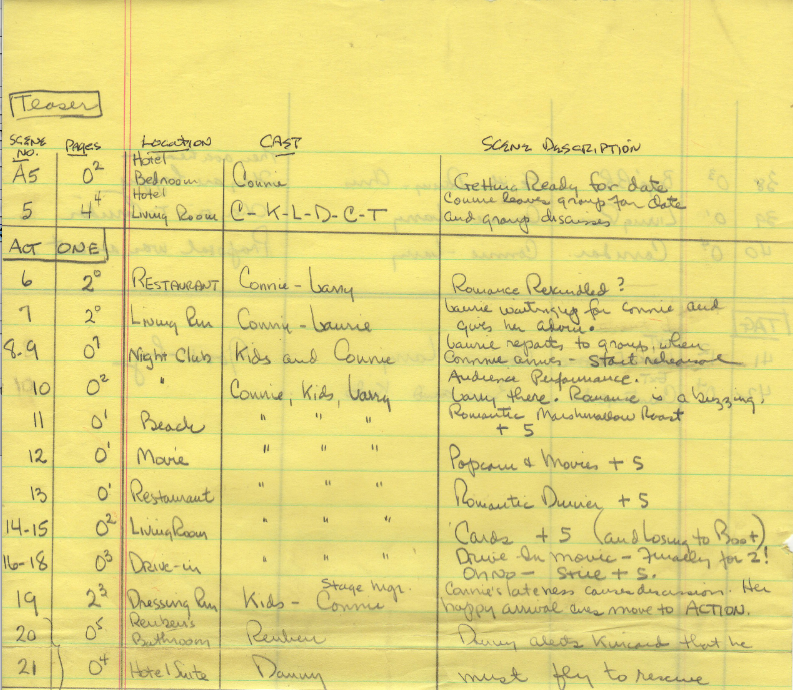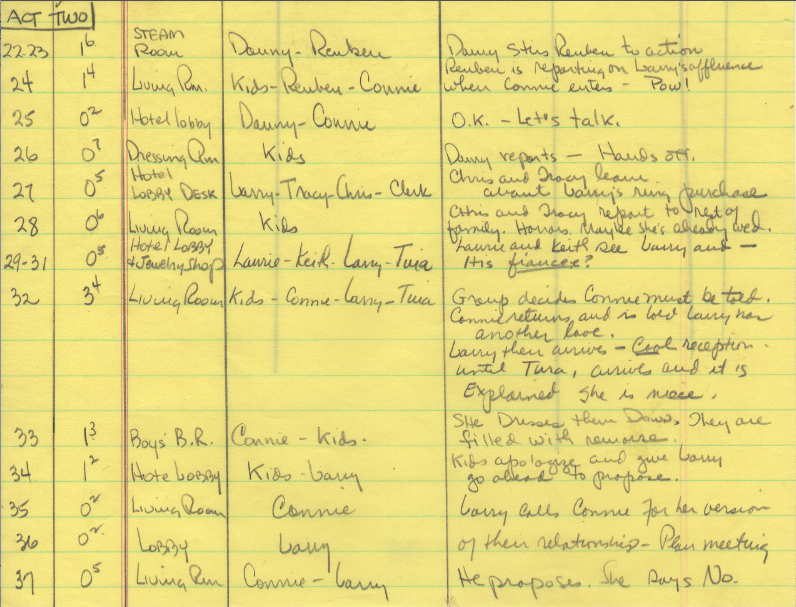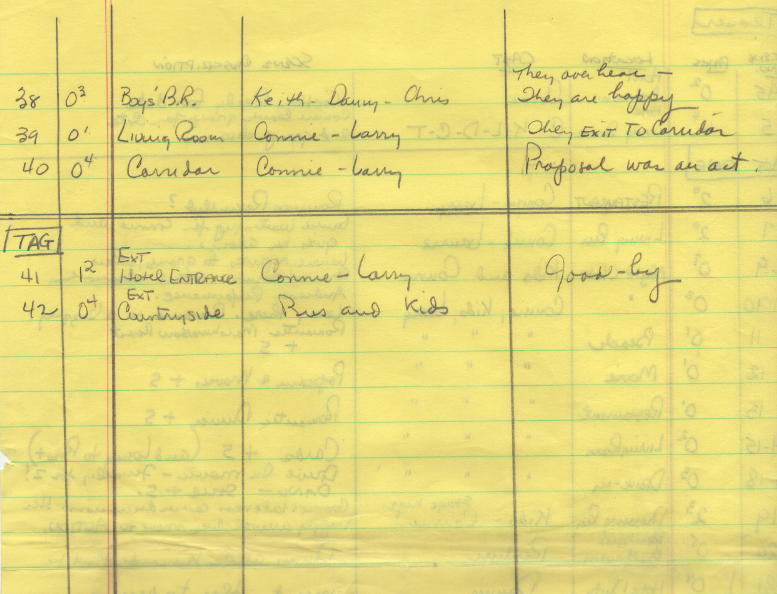FILMED June 1970
(The film clip of me is from a recent interview by the Archive of American Television, a division of the Academy of Television Arts & Sciences Foundation.)
My previous nine outings on THE COURTSHIP OF EDDIE’S FATHER had really been as much “dramedy” as comedy. By this time I had also directed episodes of THE BILL COSBY SHOW (not the later THE COSBY SHOW about the Huxtable family but his first comedy series about a gym instructor). And the prospect of working on a musical series was interesting and challenging.
A technique I had been introduced to very early in my training as a stage director was to break the script down into French scenes. A new French scene occurs whenever the number of characters in the scene changes; in plain words when a new character enters or when one of the characters in the scene exits. It is a way of breaking the script down into manageable units. For film I found the structure of the screenplay most of the time already had the script broken down into comparable units. So at the start of every project I would make a chart like the following one for this episode.



The script I was assigned, WHEN MOTHER GETS MARRIED, was written by the show’s creator, Bernard Slade. I thought the plot for the episode did not dig too deeply into the possible seriousness of the situation and that if at times it was predictable, his dialogue was very actable; more importantly, it was funny. I found him to be a very gifted comedy writer.
In the next year I would direct six more episodes of the show, but this was the only one where I had any direct contact with Bernie Slade. At this time he told me about a pilot he had just completed starring Jose Ferrer as an angel who comes to earth each week to solve some person’s dilemma. When Ferrer showed up at the studio to start production, he wore a small pierced gold hoop earring in one ear; he refused to remove it and that was the way the pilot was filmed. Bernie told me that when they screened the completed pilot for the network executives, one of those present questioned, “Why was that character wearing an earring?” Bernie’s response: “Where else would an angel wear his halo when visiting earth.” I told you he wrote funny dialogue.
The production schedule for THE PARTRIDGE FAMILY was unlike the one on THE COURTSHIP OF EDDIE’S FATHER. Monday was assigned as the day for a production meeting followed by a reading of the script by the cast and then a rehearsal. The next three days were for filming. Friday was a pick-up day when needed; usually musical numbers that had not been completed would be filmed at that time. So on my first Monday I reported to the studio, had the production meeting and then met with the cast for a reading and a rehearsal. Big mistake! The combination of lightweight material and a cast with so many children didn’t work well for a reading around a table followed by a rehearsal. That was the first and last time I tried that. And the actors were happier with the day off.
If the material was lightweight, the guest casting was not. John McMartin was cast as Larry, Shirley’s date. The year before John had starred in the film version of SWEET CHARITY, a role he had created in the Bob Fosse Broadway production. The following year he would be one of the stars of Stephen Sondheim’s Broadway production of FOLLIES, my favorite Sondheim musical. John was a magnificent stage actor. When FOLLIES came to the Schubert Theatre in Century City on its national tour, I experienced a rare and exciting moment in theatre. In the second act each of the four main characters had a musical number reflecting their personal emotional problem. For his number John danced in the center of a long line of Rockette-type chorus girls. In the middle of the number John suddenly went out of step with the line, then stopped, frozen, as if he had suddenly lost it. It was mesmerizing and frightening. I truly thought John was having some sort of seizure. But he recovered, the dance continued and I realized it was the character having the disoriented moment, not John. When I returned to see the show a second time several months later, John had left the production. I waited anxiously for that exciting second act moment. But when it came, the replacement went out of step for a moment, then he picked it back up. He had executed the stage business, but only superficially. He had filled John’s space on the stage, but he couldn’t fill his shoes.
I was not happy with the set for our musical number. I didn’t think a rock group with five minors would be playing in a nightclub. I thought they would be appearing in concert halls or on college campuses. I knew the reason for the nightclub set – it required fewer extras. But I was still the new kid on the block so I didn’t make any waves. Besides this sequence needed Larry to be in the audience so it could segue into a montage which was the background scoring for Shirley’s courtship by him.
Dave Madden, who played Reuben, their manager, would be pretty much restricted to playing variations of this scene throughout the run of the series. Eleven year old, precocious Danny Bonaduce was a find. I don’t know what the original plans were for the character of Danny, but I’m sure that once Bonaduce entered the picture, those plans were expanded. Danny had a natural, instinctive flair for delivering comedy lines. And more importantly he did it with total reality. He was an amazingly good actor for one so young. Incidentally that was not steam in the scene. It was created by a bee smoker, not as warm as steam but it always gave me a headache.
Larry’s niece, Tina, was played by twenty-four year old Jaclyn Smith just six years before she became one of CHARLIE’S ANGELS.
When I was booked to direct this episode, I was also booked to direct an episode of THE INTERNES, a new medical series being produced by the same unit at Columbia Studio. I was scheduled to start prep on that show when I finished WHEN MOTHER GETS MARRIED, but before I could report, I was notified the episode was cancelled. Fred Silverman, the new head of production at ABC, had told the studio the script for that episode was unacceptable. The studio’s answer was that they did not have another script ready; that they would have to close down production, which would be costly.
Mr. Silverman asked, “How costly?”
The studio’s reply: “$180,000.00.”
Mr. Silverman: “You’ve got it.”
Tne network coughed up the $180,000.00; production on THE INTERNES closed down, and I was paid my director’s salary and rebooked to direct another episode at a later date. But the story doesn’t end there. A couple of weeks later I was back at the studio on a Friday to complete filming the musical number for WHEN MOTHER GETS MARRIED. Jim Hogan, the production manager for both THE PARTRIDGE FAMILY and THE INTERNES, took me aside to tell me that the script for THE INTERNES that had been rejected by the network was starting to film the following Monday. He added that no changes had been made in the script; the script going before the cameras in three days was the same script that had been rejected.
The journey continues



The chart is interesting – notice that Shirley Jones’ character name is still “Connie”, as it was in the pilot. She was renamed “Shirley” for the series, the pilot was recut before airing to eliminate any mentions of “Connie”.
Sharp, Mark, sharp! I never noticed.
LOVED John McMartin! Was so unbelievably fortunate to see him on Broadway seven years ago, in a riotous turn as a drunken boss in “Anything Goes”! If I’m not mistaken, he worked with Shirley once more, years after this episode! I know he often worked with Angela Lansbury-once on Broadway, several times on Murder She Wrote! Great actor!
John McMartin was a cassidy family friend, and played Shaun’s father in a stage production tour of The Subject Was Roses as well as the Christmas themed sequel to Roots (Roots the gift). He was also Shaun’s godfather
The only song you shot where none of the voices belonged to anyone in the group, including David. Loved the transition from rehearsal to the concert. Based on your show notes, it appears not all segments made it into the program. Perhaps they would have if the song was played in its entirety. But once again, there was that challenge of trying to fit an hours worth of scenes into a 30 minute program (with commercials). Must have been frustrating to discover later on that the set up, rehearsal, and filming of certain scenes would not be used. Back to me wishing you were also in the editing room where you could have preserved those scenes. No doubt that were all thrown away instead of being archived somewhere.
But the system was that I was in the editing room to do what they called the director’s cut. That meant making sure each scene was as I wanted it, but I COULD NOTD ELIMINATE any scenes.
Should have known you were in the editing room as it does have a “Director’s cut” feel to it. But knowing that also hurts as my time machine would have you preserving the clippings in your suitcase as you left the editing room. Someone apparently did just that as there are blooper reel compilations posted on YouTube. I see those clips and it is like watching home movies from my childhood as the Partridges were like a second family to me (my Friday night family). That one night of the week where I was “Doug Partridge”. Certainly filled a void that my non-fictional family couldn’t cover. Now if only I could find all of “Getting Together” programs. There is a very special song to me called “Jennifer” by Bobby Sherman (fall of 1971) and I keep hoping you filmed a performance video of Bobby singing that song for the program. I hang onto the hope that it’s somewhere in a media storage vault waiting to surface.